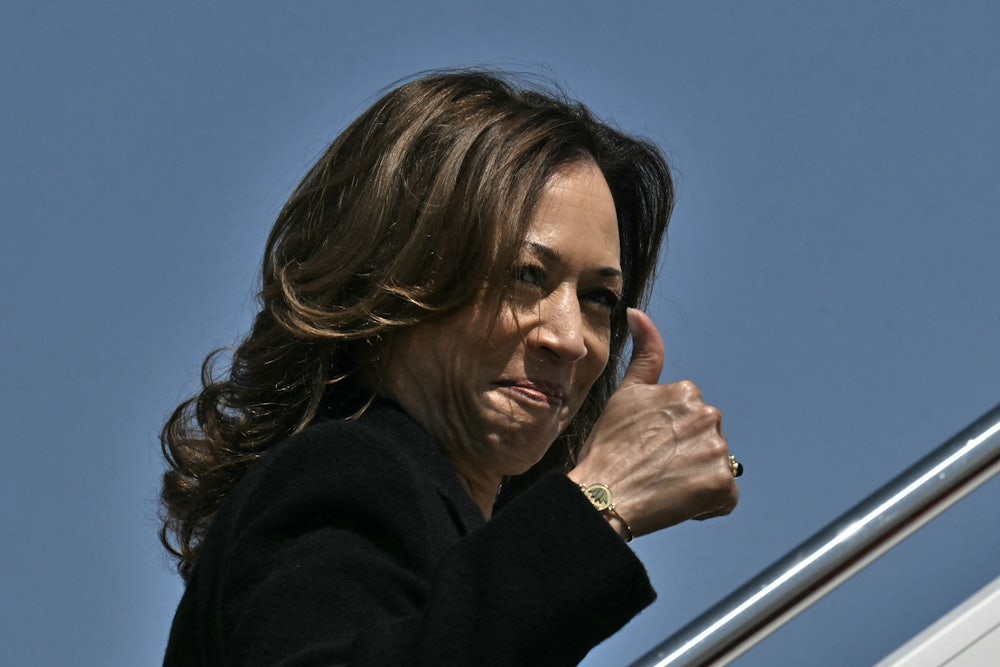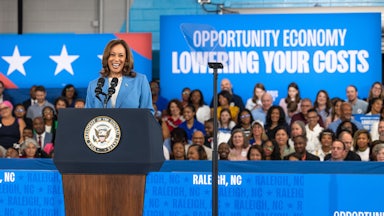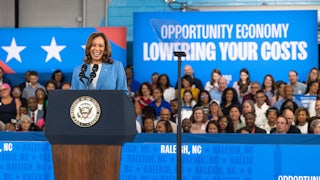“Where has this Kamala Harris been all along?” That was the question Time magazine posed three weeks after the vice president replaced President Joe Biden as the Democratic Party’s presidential nominee. Harris, author Charlotte Alter noted, had been “underestimated” by her party as vice president; stories about her lackluster performance, often borne aloft on the strength of anonymous Democratic “insiders” with quotes at the ready, had been a mainstay during her time as Biden’s veep. As the Democratic nominee, however, there was nary a discouraging word. Instead, Harris found herself riding a wave of enthusiasm and seemed made for the moment: “A former prosecutor running against a convicted felon, a defender of abortion rights running against the man who helped overturn Roe v. Wade, a next-generation Democrat running against a 78-year-old Republican.”
Time was hardly the only outlet that noticed a transformation: This was not the same politician whose presidential bid crashed and burned five years ago. The Financial Times’s Edward Luce noted “a metamorphosis from indifferent vice-president to the source of Obama-scale enthusiasm” that had “caught almost everyone unawares,” marveling that a “once-in-a-generation” natural had been hiding behind the scenes. The New York Times charted her rapid evolution from sidelined vice president to arena-packing presidential candidate. A consensus quickly emerged: Harris had, without anyone noticing, become a force to be reckoned with, if not a generational politician.
Three months into her presidential campaign, a more nuanced portrait has emerged. Harris has, in most respects, defied skeptics (myself included) and quieted concerns about her appeal. The doubts about her ability to lead a presidential ticket were clearly unfounded: Harris is a strong candidate (and even better debater) who can win the election in November—all things that could not have been said about Joe Biden.
It is also increasingly evident that Harris is not a significantly different politician than she was five years ago. During her first presidential campaign, Harris struggled to articulate a larger thesis for her candidacy and largely failed to support her thin premises with a coherent policy program; she adopted and shed positions seemingly at random; she struggled when speaking to the media. She has since improved in most of those areas, but weaknesses remain. More than anything else, Harris has benefited from a change in context rather than some self-driven alteration: She is undoubtedly better suited to run a general election campaign than she was to run in a primary.
Harris is now more successfully executing the strategy that failed to catch fire in the 2020 Democratic presidential primary, running as a protector of both the middle class and American democracy against a plutocratic, authoritarian opponent. She is also repeating many of the same mistakes: She is overcautious and reluctant to stake out positions; her priorities and approach to policy remain murky; her messaging is often overbroad. As the campaign enters its final stretch, Harris’s first, failed presidential run is increasingly instructive: She is, in many ways, running the exact same campaign now that she did five years ago and hoping for a different result.
In January 2019, when Kamala Harris entered the Democratic presidential primary, her party was in a strange place. The notoriously disorderly Democrats had spent two years in uncharacteristic lockstep, doing everything they could to stymie Trump’s increasingly belligerent presidency. But the party was also in the fourth year of an existential crisis: Everyone agreed that Trump had to be stopped, but no one could agree on how to do it.
The 2020 Democratic primary quickly became a supersized version of the 2016 contest, a surprisingly competitive fight between establishment paragon Hillary Clinton, who embodied the party’s embrace of triangulation and centrism, and Bernie Sanders, who pushed universal policies and democratic socialism. When the 2020 primary began, the party remained unsure of its direction: Would it embrace the robust, universal policies pushed by Sanders? Or would it continue to take a more moderate approach? As candidates entered the race, they were quickly sorted into progressive and “establishment” lanes: This rehash of the 2016 contest suddenly had more than a dozen contenders, competing to play one of the two roles available—consummate outsider or reliable institutionalist.
A former prosecutor and recently elected senator, Harris was undoubtedly running in the establishment lane. But her pitch to voters was broader. Harris wasn’t interested in bickering and infighting or, for that matter, relitigating the last primary. For that matter, she didn’t really have an answer to bigger questions about the party’s identity and direction. Instead, her campaign was premised on the idea that Democratic voters were ready to move on and focus on what ultimately mattered: beating Donald Trump.
It was an approach that attempted to turn her biggest liability into an asset. Harris had little policy experience and almost no legislative record: a blank space that permitted her to run as a candidate who could both occupy the center of her fractious party while plausibly representing a clean break from the fissures that had emerged over the previous half decade. Hers was a campaign with one foot in both lanes. Over the course of her 11-month campaign (and particularly as it began to falter), she adopted a grab bag of leftish policies—mandatory assault weapon buybacks, banning fracking, an “openness” to expanding the Supreme Court. Harris wanted to be the establishment candidate who could appeal to progressives.
She was successful—briefly. She won the party’s first presidential debate by delivering a blistering attack on Joe Biden’s past work with segregationists and his vocal support of busing. She exposed Biden, her biggest rival in the “establishment” lane, as old and out of touch. The result was a media coup: Her performance all but announced Harris as a candidate who represented a serious break from the party’s past. It also positioned her as Obama’s natural successor—no small feat, given that Biden had literally served as his vice president. In the wake of the debate, she soared in the polls.
She crashed back to earth just as quickly. Harris’s attack on Biden invited a natural follow-up question: What precisely was her position on busing? She took days to answer. When she did, she told reporters that she, in fact, did not support federally mandated busing and instead saw it as a “tool” for school districts. This was, as many quickly pointed out, the exact same position held by Joe Biden. Harris responded to that criticism by amending her previous answer: Busing, she said, was necessary in the 1960s and ’70s but not today. This strange cycle, in which Harris would briefly garner attention for doing something bold or unique, only to then vitiate the power of her own position by seeming reluctant to actually commit to it, would mar her campaign repeatedly: Harris would stake out a policy position, face some gentle criticism or scrutiny, and then “clarify” her stance into something mushier, often by materially changing it.
Ascendant, Harris faced increased inspection from the press on the campaign trail and sharper attacks from her rivals on the debate stage. Her response to both was often maddeningly vague. Asked about her approach to politics in July 2019, Harris told The New York Times that “policy has to be relevant. That’s my guiding principle … there are tests that I have for the relevancy or the significance of policy, but it’s not an ideological test.” What were these tests? Either she didn’t really know or she wouldn’t really say.
Harris’s dodges were essentially part of her larger strategy: She didn’t want to say anything that could jeopardize her standing as a unifier. She wasn’t this avoidant on every issue—her answers and positions on climate change and abortion were particularly strong. But in practice, her shifting-sands approach often made her seem either opportunistic or, at times, vacuous. Taken as a whole, Harris demonstrated an approach to politics that was remarkably—and at times destructively—cautious.
Harris has held onto this approach for far too long. As the 2020 primary season progressed, and the other candidates grew more and more policy-focused, it became the wonkiest in recent memory. Harris, who continued to stake out a broad, Obama-esque position on most issues, increasingly found herself isolated. It often seemed like she was running in a different race than policy nerds like Elizabeth Warren and Pete Buttigieg, who quickly surpassed her. Meanwhile, voters looking for a centrist choice had options who rarely strayed from that lane, such as Biden or Amy Klobuchar. Meanwhile, her appeals to progressives started to falter as well, as her record as a prosecutor was examined and criticized as being out of step with the increasingly social justice–minded Democratic Party.
Once again favoring a cautious approach, Harris at first barely responded to these attacks, perhaps fearing that doing so would only further strain her credibility with the left. This didn’t last long. Without much of a policy record to run on beyond the positions she had now either undermined or obscured in her effort to sand down her edges, her campaign eventually metamorphosed into something more clichéd—Harris as prosecutor par excellence, complete with a new slogan, “Justice is on the Ballot.” But by the time she made her way back to her safe default setting, it was too late to claw her way back into the primary.
Her message—or lack thereof—was the problem. Harris continued to pitch herself as a unity candidate, but her reluctance to take clear policy stances resulted in muddled, seemingly improvised rhetoric. By the end of the year, she found herself in what Vox’s Christian Paz described as a “‘no person’s land’ to the left of the centrists and to the right of the leftists,” a unity candidate who ultimately didn’t really appeal to anybody. On December 3, 2019, she suspended her campaign, two months before a single ballot was cast.
Five years later, Harris finds herself in a much more enviable position. With about a month to go until Election Day, Harris is consistently leading Donald Trump in national polls and has a narrow edge in enough swing states to make her a slight favorite. She has, in a surprisingly short period of time, done something remarkable in this political moment: When she became her party’s presumptive nominee, a clear majority viewed her unfavorably; now more see her positively than negatively. At the start of summer, when it became clear that Joe Biden’s reelection bid was doomed, many in the party panicked about the electoral viability of Harris, his most likely successor. That anxiety was clearly misplaced. Harris is not running a perfect campaign, but she is running a far more successful one than Biden was.
Harris has undoubtedly grown as a politician: Her time as vice president has made her a more polished speaker with a greater command of policy. The shift in her electoral prospects—from a primary campaign polling in the low single digits to a general election one regularly hitting 50 percent—has less to do with her evolution as a politician than it does with the way the political world has shifted around her.
Five years ago, Harris entered the primary with an expansive message that was ideally suited for a general election campaign. When that primary quickly became the most policy-heavy in American history, it faltered. Now, having been anointed her party’s nominee without a primary, Harris doesn’t have to do most of the things she struggled with five years ago. She doesn’t have to engage in drawn-out, detailed policy discussions or engage in the delicate maneuvers and triangulations crowded primaries require. She can run the kind of campaign she instinctively wants to: one built on broad strokes and big themes. Harris’s core message—that it’s time for her party and the country to come together to finally exit the Trump era—resonates far better when she is leading a presidential ticket than it did when she was competing with a dozen other challengers.
But the flaws in Harris’s approach are as clear now as they were five years ago—and they could prove to be just as disastrous now as they were then.
Five years ago, Harris’s campaign failed in large part because she couldn’t offer a larger vision for her party or the country. Then, as now, she talked about the need to lift up the middle class and to promote freedom and decency at home and abroad. But even as she has slowly fleshed out her platform, it’s still not clear what her main policy priorities would be as president. There is a general suspicion that she intends to retreat slightly from Biden’s robust, worker-friendly economic agenda and that her presidency would be more corporate friendly. (Indeed, in a big speech laying out her economic agenda, Harris echoed the vagueness of her 2019 Times interview, promising to eschew ideology and instead take “good ideas from wherever they come.”)
But what she has articulated amounts to a grab bag of ideas on par with what she offered in the last Democratic primary: a mix of progressive and neoliberal policies (with lots of tax credits and populist bromides) that suggests no real core ideas about domestic policy. Five years ago, Harris tried to dodge the question of what the Democratic Party should be and how it should govern; today, it’s still not clear she really has an answer.
This approach is far more defensible in a general election than a primary: Harris is trying to run a big-tent campaign; the policies that she has adopted reflect that. But that approach carries risks as well: Many of her moves, like her adoption of Trump’s (stupid) “No Tax on Tips” proposal suggest rank opportunism instead of deep knowledge. And she’s fallen back on old habits: Harris spent most of the early days of her campaign disavowing various progressive positions she adopted five years ago.
To the extent that her campaign has a working theory, it is that the electorate has moved to the right since Biden’s election four years ago, when he won promising an “FDR-sized presidency.” It was a promise he largely kept, even while stymied by narrow margins in Congress, pushing economic policies that embraced full employment and public spending.
Yes, August’s Democratic National Convention was defined by its embrace of unions, working people, and economic fairness. Harris’s most effective attacks on Donald Trump have rightly targeted the fact that he is a plutocrat in populist’s clothing. But there is no talk of taking inspiration from the New Deal or expansive bills that remake the economy—nothing, in other words, that could bolster the ridiculous attack that Harris is a closet Marxist. Frankly, on economic issues, she may not even be a closet Joe Biden.
On immigration, meanwhile, Harris’s position—which is, to be clear, also Biden’s—is not significantly different from the one Republicans ran on during the 2018 midterms. There is no more talk of immigration as a virtue in and of itself—a staple of Democratic discourse during Trump’s presidency—nor has Harris done much to speak up in defense of the Haitian immigrants who have been targeted by racist lies from Trump and his running mate, JD Vance. Instead, when the topic of immigration comes up, she trumpets her support for a bill “written by some of the most conservative members of the United States Congress” that, if enacted, would be the harshest immigration law passed in more than half a century.
Pivoting to the center is what campaigns do, of course, and there is a clear electoral logic to Harris’s maneuvering. But, having disavowed much of her 2020 platform, there is at times an impression that her campaign consists almost entirely of pivots. Harris’s affection for pivots and shift to the right was recently encapsulated by a revealing answer to a question during an appearance on The View. Asked how she would differ from Biden, Harris first dodged the question—before answering it by saying she would include a Republican in her Cabinet.
Harris didn’t emerge from a competitive primary; as a result, her policy platform is light on specifics. (Trump’s, it should be said, is far lighter.) Instead, one largely has the sense that she’s doing precisely what she did five years ago. Then, both the prevailing mood and the primary dictated she adopt a number of progressive policies. Now, running in a general election in which voters have soured on immigration and the economy, she has lurched rightward. A degree of pragmatism is both necessary and laudable in politics; Harris has little choice but to consider a very unfavorable-to-Democrats Senate map as she campaigns for herself. But at no point in either election do you a have a clear sense of how Harris approaches policy more broadly.
That has not been helped by her campaign’s media strategy. She is generally averse to interviews. Without a clear sense of her agenda, there are times when her campaign seems to consist solely of pivots. Here too, Harris is repeating a mistake from five years ago, when voters rejected her campaign for its lack of both vision and detail. With 30 days to go, she has picked up the pace somewhat, appearing on more podcasts and news shows—especially in recent days, when she has done several interviews, most notably with 60 Minutes and The View. But this transition has been belated; her campaign has, by and large, adopted the same press-allergic strategy favored by the Biden reelection campaign. In interviews, Harris is charismatic; her running mate is appealing and telegenic. But they are few and far between because her campaign has adopted a “do no harm” approach that also clearly isn’t doing much good.
All in all, Harris is as maddeningly cautious as ever. There is still a pervasive sense that she prioritizes dodging potential controversies over taking action or, for that matter, staking out a clear stance. In the presidential debate, for instance, Harris dodged nearly every question that asked her to forthrightly define her position. In the vice presidential debate, Tim Walz—once a source of unfettered excitement and enthusiasm—was defanged and restrained. These performances suggest another explanation for her campaign’s aversion to doing interviews: She often doesn’t have specific answers to questions about, say, what her specific position on abortion is or how her economic policies would combine to, say, lower inflation. Although ramping up, her campaign is still oddly low profile—interviews are rare, as are rallies.
Naturally, it’s possible that none of this will matter. One explanation for Harris’s reluctance to offer more concrete details about her plans is that her campaign believes that she simply doesn’t have to. The contrast between Harris and Trump is already clear, and her campaign is focused almost solely on making that distinction as clear as possible. Policy rollouts and interviews are inherently risky and, if bungled, would only distract from that message. Given the threat posed by Donald Trump, after all, the details don’t really matter. Harris’s squishiness is, from this point of view, an asset insofar as it represents yet another contrast with her dogmatic and extremist opponent. But with Election Day fast approaching, there’s a growing sense that she could—and should—be doing more.











